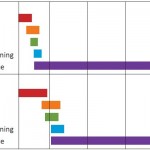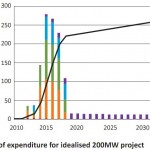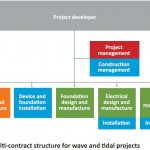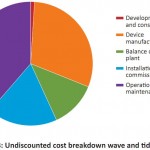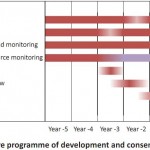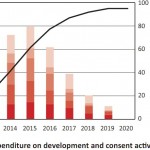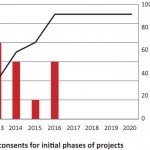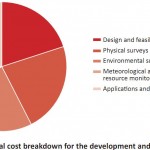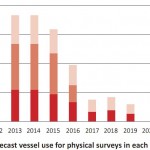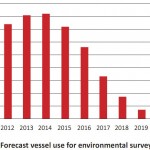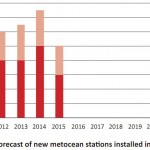Development
Development and consenting activities dominate expenditure during the early years of the PentlandFirth and Orkney Waters projects. The process began in earnest during 2010, and based on thedevelopers’ schedules, it is generally expected to be up to five years before installation takes place(although for some projects work is planned in shorter timescales).
For each project, initial surveys and investigations are used to define the project outline design. These activities are undertaken several years prior to revenue generation and with a risk that the project will not be granted planning consents. As a result expenditure levels are kept to a minimum with additional more detailed worked carried out once planning consents are granted.
Although of key importance to the success of a project, relatively little investment is required during this project stage compared to that in the manufacturing, installation and operation stages. Overall investment for each project of up to £10 million is expected to be spread over the years preceding construction of each project phase. Smaller projects are likely to require a proportionally higher spend on development and consenting as many costs do not change significantly in relation to the total capacity installed.
For all projects, initial development and consenting activities are now well underway. Significant expenditure on these activities is expected to have been committed by the end of 2013, and if work proceeds on track in accordance with the developers’ milestones then most activities will have been completed by the end of 2016. In order for the projects to proceed as scheduled, consents for the initial phase of the early projects will be required in 2013; with consents for all initial phases required by the end of 2016.
Project developers are expected to procure most activities in this stage of project delivery directly. In some cases, they may contract first tier suppliers to deliver a broad scope of work, with specialist activities subcontracted further as required. There will be variations between the scopes of contract awarded for each project due to the specific needs of individual project developers. Utility project developers are establishing small project teams to manage subcontract activities, but activities related to financial evaluation and technology selection are likely to be delivered by in-house resources, calling on subcontractors only for specific tasks. Other project developers anticipate outsourcing these services to a greater extent.
Examples of activities include:
- Development of device arrangements and routing of subsea array cables using data gathered from surveying and resource monitoring;
- Grid connection feasibility and integration with national network;
- Engineering design of balance of plant systems and components, broadly covering mechanical, electrical and structural engineering disciplines;
- Marine logistics studies to optimise installation methods, vessel and port requirements;
- Development of contracting strategies for all services throughout the project’s life cycle; and
- Techno-economic analysis to determine the expected costs and revenues arising from the project to facilitate eventual financial investment decisions.
Organisations with a track record in the marine environment, perhaps gained from industries such as oil and gas or offshore wind, fishing, marine aggregates extraction or similar, may be well placed to undertake this work. Competencies and services relevant to these activities include:
- Knowledge of the site-specific conditions in and around the projects; gained through operation of vessels or offshore construction in and around the Pentland Firth and Orkney waters. This includes occurrences of extreme waves and irregular tidal flows throughout the lunar cycle as well as knowledge of seasonal sea state patterns.
- Relevant technical knowledge in marine renewables or parallel sectors, including pressurised vessels, marine equipment and aquaculture.
- Understanding of subsea electrical equipment with consideration of access for maintenance and comparison of cost of increased redundancy or reliability compared to more maintenance.
- Experience in construction planning and methods suitable for short access windows due to tidal flow or high wave environments.
- Health and safety culture and processes including designing out the need for diving operations wherever possible and considering the failure modes of key components.
To view further detail please read the Content Source: The Crown Estate, May 2011 – Wave and Tidal energy in the Pentland Firth and Orkney waters: How the projects could be built.

